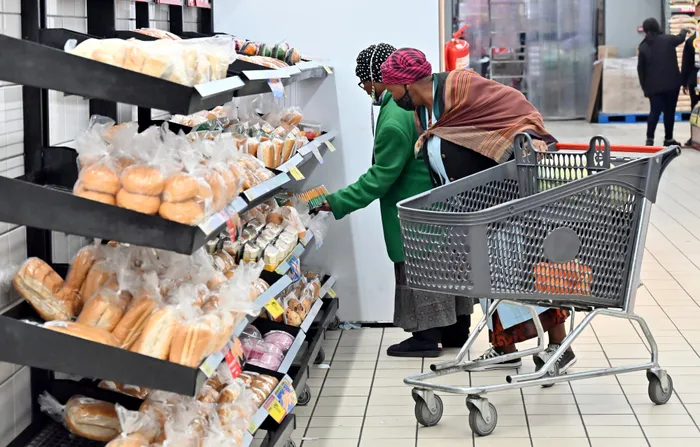
This past week, data released by the Pietermaritzburg Economic Justice and Dignity (PMBEJD) in its April 2025 Household Affordability Index showed that the price of a basic food basket increased by almost R100 month on month.
Image: Ayanda Ndamane/ Independent Newspapers.
While the latest inflation data for South Africa showed an easing, food prices in the country saw a sharp increase.
This past week, data released by the Pietermaritzburg Economic Justice and Dignity (PMBEJD) in its April 2025 Household Affordability Index showed that the price of a basic food basket increased by almost R100 month on month.
In April, consumers had to fork out R5 420.30 to fill up a basic food basket. That means the average cost of the Household Food Basket increased by R90,94 (1.7%), from R5 329.36 in March 2025 to R5 420.30 in April 2025.
The average cost of the Household Food Basket increased by R83.99 (1,6%), from R5 336,31 in April 2024 to R5 420.30 in April 2025.
In April, of the 44 foods tracked in the basket, 24 foods increased in price, and 20 foods decreased in price.
While consumer priced inflation softened, it was mainly attributed to lower fuel prices, while food prices remained the same or saw an increase.
Foods in the basket which increased in price in April 2025 by 5% or more, include: potatoes (6%), onions (11%), beef (7%), fish (7%), tomatoes (26%), carrots (20%), spinach (7%), cabbage (6%), green pepper (7%), bananas (7%), and oranges (18%).
Foods in the basket which increased in price in April 2025 by 2% or more, include: maize meal (2%), full cream milk (2%), beef tripe (2%), cremora (3%), apricot jam (4%), and brown bread (2%).
Foods in the basket which decreased in price in April 2025, by 5% or more, include: butternut (-7%), and apples (-6%).
Foods in the basket which decreased in price in April 2025, by 2% or more, include: rice (-4%), cake flour (-2%), sugar beans (-3%), salt (-2%), frozen chicken portions (-3%), stock cubes (-2%), soup (-3%), tea (-3%), margarine (-2%), and peanut butter (-2%).
Gloomy day for workers
As the country celebrated workers day this past Thursday, the numbers showed that there was not much to celebrate.
The national minimum wage in South Africa is R28.79 per hour, R230.32 for an 8-hour day, and R4 836.72 for an average 21-day working month.
In April 2025, with 19 working-days, the maximum National Minimum Wage for a General Worker was R4 376.08.
"Workers work to support their families. The wage workers earn is not just to sustain themselves alone, it is used to support the entire family. For Black South African workers, one wage typically must support 4 people. Dispersed in a worker’s family of 4 persons, the NMW, is R1 094.02 per person, this is below the upper-bound poverty line of R1 634 per person per month," the PMBEJD stated.
The April 2025 average cost of a basic nutritional food basket for a family of four persons is R3 817.78.
The group added, "On our calculations, using Pietermaritzburg-based figures for electricity and transport, and the average figure for a minimum nutritional basket of food for a family of four, puts electricity, and transport, taking up 58.6% of a worker’s wage (R2 562.97/R4 376.08)."
"Food is bought after monies for transport and electricity have been paid for or set aside (leaving R1 813.11 – for food and everything else), and so in April 2025, PMBEJD calculates that workers’ families will underspend on food by a minimum of 52,5% (having R1 813.11 left over after transport and electricity have been paid, and with food for the month costing R3 817,78). In this scenario there is no possibility of a worker being able to afford enough nutritious food for her family. If the entire R1 813.11 all went to buy food, then for a family of 4 persons, it would provide R453,28 per person per month. This is below the food poverty line of R796," the PMBEJD further stated.
Neil Roets, CEO of Debt Rescue said that the figures reflect a brutal truth, that millions of South Africans are no longer coping.
Roets said, "To survive, many are turning to credit cards and payday loans just to buy groceries. We’re seeing a sharp rise in consumers using short-term credit to put food on the table.”
Hygiene items are also increasingly unaffordable.
The cost of basic household hygiene products has risen to R1 033.09, up 2.6% from last year.
“When food and hygiene compete for the same shrinking budget, something has to give—and it’s often health and dignity,” Roets added.
“People aren’t overspending or living recklessly. They’re doing everything right, but the numbers no longer work. They are trapped in a cycle of survival, borrowing just to eat, and falling deeper into debt every month,” he said.
“The April 2025 Household Affordability Index confirms what we see every day: the cost of survival is rising faster than people can keep up. South Africans are at breaking point right now under the combined onslaught of food prices that have increased far above the inflation rate, interest rates that are still among the highest they have been in a decade and the relentless financial onslaught from Eskom for an essential service that is also vital to the survival of households. Where to from here?”, Roets asked.
BUSINESS REPORT